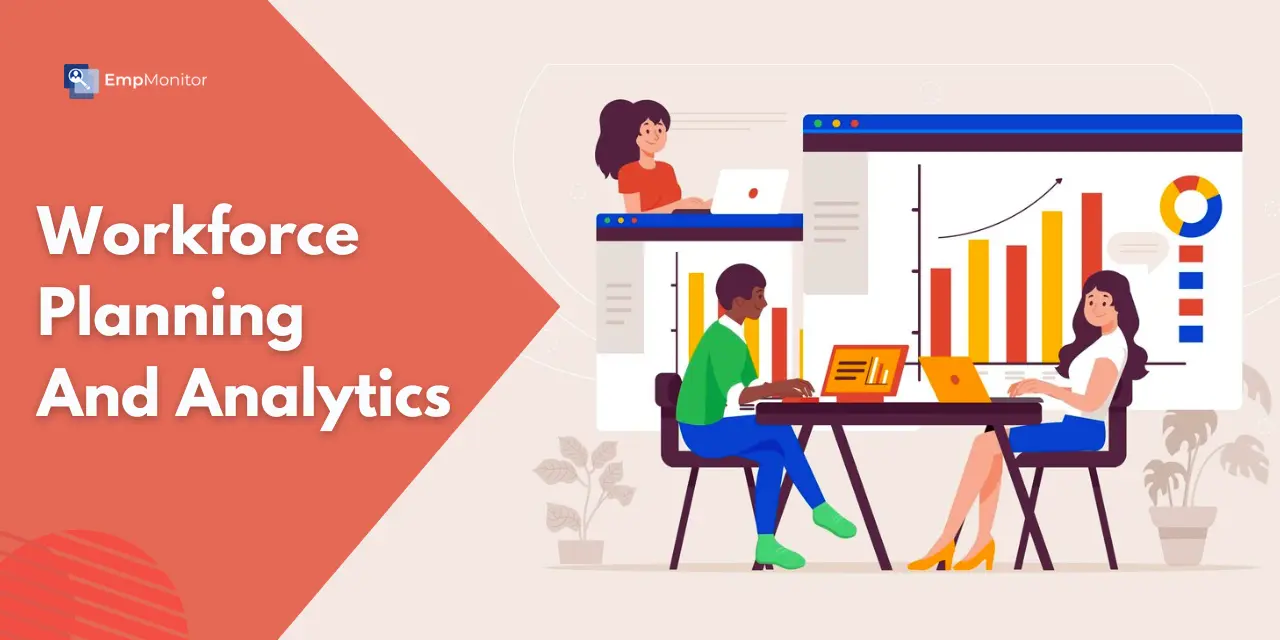Do you ever wonder how to make sure you have the right people working when you need them? Workforce planning and analytics can help you figure things out in today’s fast-changing businesses.
Knowing exactly how many people you need to do the job well can help you deal with problems in staffing. It makes sure everyone is happy and working efficiently.
In this blog, we have discussed how planning and analyzing your workforce benefits businesses. We’ll discuss how they help you understand your staffing needs, improve operational efficiency, and make informed decisions. Come along as we uncover the importance of managing your workforce effectively in today’s digital world.
Listen To The Podcast Now!
What Is Workforce Planning And Analytics?
Workforce planning analytics is the art of strategically managing an organization’s human resources. It encompasses evaluating current workforce capacities, projecting future needs, and devising plans to fulfill them in line with organizational objectives.
The objective of workforce planning is to synchronize workforce demands with business aims. Organizations can make informed choices regarding recruitment, training, retention, and succession planning through data-driven insights.
Conversely, workforce analytics entails employing data and statistical analysis to understand workforce dynamics, performance, and efficiency. Organizations can refine their workforce strategies, bolster employee commitment, and elevate overall operational effectiveness through this approach.
If one were to initiate a strategic workforce planning process today, it would involve the following steps:
- Evaluate the current state of the workforce.
- Envision the desired future composition of the workforce.
- Identify skill gaps and resource requirements.
- Formulate an action plan to propel the team forward.
Why Workforce Planning And Analytics Are Important?
Utilizing data-driven insights, workforce planning, and analytics enables informed decision-making to reduce uncertainty, bridge workforce gaps, and enhance performance.
Enhance your workforce composition, nurture talent, and strategize for success by incorporating planning and anlaytics into your approach. You can employ this approach to:
- Identify and recruit candidates whose skills and expertise align seamlessly with each role and exhibit potential for long-term development.
- Anticipate high-performing employees by assessing their skills and achievements, thereby facilitating effective retention strategies.
- Explore the factors contributing to employee engagement to enhance performance bars and foster retention rates.
- Harmonize talent management objectives with organizational aspirations to ensure alignment and synergy.
- Execute succession planning initiatives and identify prospective candidates for advancement opportunities.
Incorporating planning and analytics into your operational framework equips you with the workforce planning software necessary to optimize talent utilization, cultivate a culture of growth, and drive sustained organizational success.
Factors Contribute To Planning And Analytics
Workforce planning and analytics involve strategic processes that help organizations manage their human resources effectively. Effective workload planning and analytics depend on several important things:
Good Data:
It’s crucial to have accurate and reliable data. Organizations must ensure that the information they use is current, stays the same, and directly helps them make wise choices.
Right Technology:
Utilizing correct tools and systems is vital for planning and analytics. It means using HRIS (Human Resources Information Systems), data analysis platforms, and other tools that help gather, analyze, and display workforce data.
Involving People:
It’s crucial to involve authorities like HR professionals, business leaders, and department heads in the workforce planning and analytics process. It ensures everyone is on the same page with the organization’s goals.
Having The Right Skills:
Organizations need employees who know how to analyze data, understand statistics, and do workforce planning. Providing training in these areas can make the organization better at using workforce analytics.
Keeping An Eye On Things:
Planning and analytics should happen all the time, not just once in a while. Regularly checking workforce data and metrics lets organizations change their strategies as needed.
Following Rules And Being Ethical:
Organizations must establish their planning and analytics follow the law and are ethical, especially when dealing with private employee information.
By thinking about these things and including them in their planning and analytics, organizations can make better decisions, improve workforce strategies, and succeed in their business goals.
Should You Use Workforce Planning and Analytics Software?
Yes, planning and analytics software for the workforce is essential for organizations dealing with complex structures and extensive workforce data. Larger enterprises benefit from the software’s ability to handle diverse variables efficiently.
However, smaller organizations with limited budgets and fewer needs may initially rely on fundamental tools. Nowadays, organizations have started using workforce management software like EmpMonitor to effectively plan and manage workforce and resources.
EmpMonitor: To Empower Your Workforce Management
EmpMonitor is a comprehensive employee monitoring software designed to streamline employee monitoring and optimize organizational productivity. With a suite of robust features, EmpMonitor offers businesses the tools they need to monitor, analyze, and enhance employee performance while ensuring compliance with organizational policies and regulations.
Time And Attendance Tracking:
EmpMonitor simplifies workforce planning and analytics through its time and attendance tracking. It provides real-time visibility into employee schedules, shifts, and absences. Managers can easily monitor attendance trends, streamline scheduling, and ensure compliance with labor regulations.
Internet And Application Usage Control:
EmpMonitor enables administrators to monitor internet and application usage, ensuring compliance and security. With features such as web-blocking and access controls, it empowers organizations to enforce policies and maintain productivity levels effectively.
Employee Performance Evaluation:
EmpMonitor facilitates objective performance evaluation by providing managers with access to detailed analytics and reports. By analyzing key performance indicators and behavior patterns, supervisors can identify top performers, address performance issues, and provide targeted feedback to drive continuous improvement. All these metrics ease workforce planning and analytics.
Data Security And Compliance:
EmpMonitor prioritizes data security and compliance by employing advanced encryption protocols and adhering to industry standards. The software ensures that sensitive employee information remains protected, helping organizations maintain regulatory compliance and mitigate security risks effectively.
Customizable Reporting And Analytics:
EmpMonitor offers customizable reporting and analytics capabilities, allowing managers to generate insights tailored to their specific requirements. The software furnishes actionable insights for informed decision-making, spanning from trend analysis and productivity benchmarks to compliance audits and efficient allocation of resources.
Read More
Workforce Analytics-Its Types, Benefits & More!
How To Manage Workload Planning In 7 Steps
05 Best Strategies For Implementing Successful Workforce Planning
How To Develop An Effective Planning Strategy?

Define Strategic Objectives:
This step emphasizes the importance of aligning workforce planning and analytics efforts with broader organizational goals. Focusing efforts at different levels of the organization is crucial. Identifying specific areas for improvement is necessary. These areas include simplifying technology tools or enhancing productivity. By doing so, businesses can ensure that their workforce strategy aligns tightly with their overall strategic vision.
Analyze Your Workforce:
Workforce analytics play a crucial role in this step by providing insights into various aspects of employee performance and behavior.
Through the utilization of workforce analytics, organizations can enhance their comprehension of productivity levels, technology usage patterns, and digital distractions among various teams or departments.
Identify Gaps:
This step involves assessing the disparity between current performance levels and desired outcomes. It is a crucial step in bringing the most out of workforce planning and analytics. By determining ideal productivity levels, workload balances, and technology activity benchmarks, organizations can identify areas for improvement and set specific goals to bridge these gaps.
Set Business Goals:
With a clear understanding of the gaps identified in the previous step, organizations can develop precise plans to address them. Whether it involves implementing targeted retention programs to retain key talent or reducing IT costs through optimization strategies, setting specific business goals helps focus efforts and allocate resources effectively.
Implement Your Plan:
Execution is essential to success in workforce planning. Establishing review and reporting schedules enables organizations to monitor progress regularly and make necessary adjustments over the process.
Recognizing and celebrating successes with teams and leadership fosters a positive work culture and helps maintain momentum toward achieving strategic objectives.
The Bottom Line
Workforce planning and analytics are indispensable for modern workforce management, offering data-driven insights crucial for sustainable growth. Solutions like EmpMonitor emerge as leading allies, offering advanced analytics and intuitive features to streamline processes. EmpMonitor empowers organizations to make informed decisions, optimize resources, and foster productivity.
By leveraging workforce planning tools, organizations unlock workforce potential, identify areas for improvement, and align talent strategies with business objectives. From optimizing productivity to ensuring compliance and mitigating risks, these tools navigate the changing dynamics of the workplace environment.
Looking ahead, integrating advanced technologies and data-driven insights will redefine talent optimization. With solutions like EmpMonitor, organizations embrace innovation, drive performance, and achieve success in competitive environments. EmpMonitor is a testament to the transformative power of planning and analytics, enabling organizations to thrive in dynamic business ecosystems.












